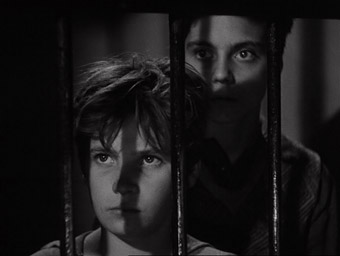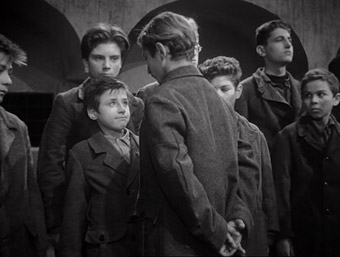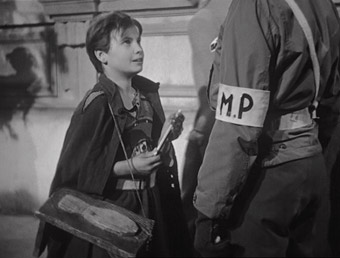|
An
unaware viewer could easily be misdirected by the first
sequence of Shoeshine [Sciuscià], which features two
boys on horseback riding furiously for the sheer thrill
of the experience. It suggests perhaps a tale set amongst
the landed gentry, for whom horse riding would have been
an essential element of country life. But to make this
assumption would require ignoring four crucial things about
the opening titles that this sequence immediately follows.
First is the title itself, an occupation – if it can so
be called – that sits at the very bottom of the social ladder. Then
there's the typeface used for the credits, not the tidy
serif font generally associated with tales of the wealthy and privileged, but a rough-and-ready hand painted lettering of the sort a merchant might
slap on a sign advertising reduced price goods. And look
closely at the background picture behind the titles – that's
no country house, but the interior of a prison. Finally
there's the director's name, Vittoirio De Sica, one of the
leading lights of Italian neorealist cinema, a movement
not exactly known for its interest in the lives of the idle
rich.
It's
a seductive opening, energetically shot, and very effectively
establishes the vigour and love for life of its two young
leads, Giuseppe and the orphaned Pasquale. This is 1945
Rome – the war is over, unemployment and economic hardship
are rife, and the only ones with any real money are the
occupying American GIs, whose shoes the two boys shine to raise enough cash to briefly indulge this shared passion for riding. When
they ride horses they are no longer poor and struggling,
Pasquale no longer has to sleep in a lift at night – for
a short time, they are truly free and kings amongst men.

Pasquale
and Giuseppe dream of buying a specific horse, but know
full well this is beyond their means. When an opportunity
arises to make some money through Giuseppe's older brother
Attilio by selling black market blankets to an elderly fortune
teller, they thus jump at it. What they do not realise is that
this is a set-up for Attilio's gang to enter the scene posing
as policemen and rob the woman blind. The money the boys
make from their role in the crime enables them to buy the horse, but
their moment of joy does not last long – with the fortune
teller's help, the bona fide police soon track them down
and arrest them.
I
should point out that this is not so much the plot of the
film as the set-up, and we are just 15 minutes in by the
time the pair have their collars felt, and five minutes
later they are in the detention centre in which much
of the rest of the film is set. Here, the two are immediately
separated, placed in different cells on different floors,
and soon find their seemingly unbreakable friendship put
at risk by the deception, indifference, and self-interest
of others.
The
opening scenes, captivating though they are, do not prepare
you for how utterly compelling the film becomes at this
point. A host of delightfully sketched secondary characters
are introduced, many of whom would later become prison drama
standards but would rarely, if ever, be as perfectly judged
or believable as they are here. The young cast are consistently
superb, and never for a second does De Sica romanticise
them or their predicament, an approach that still feels
fresh and vital, in part due to Hollywood's sentimentalist approach
to child characters and seeming inability to tell a genuinely
honest story about childhood years.
The
children are the dramatic core of Shoeshine,
young kids forced to grow before their time but emotionally
unready for the consequences. The boys soon find themselves
part of a community that is both supportive and divisive,
depending in part on which cell you find yourself in. New
bonds are formed within these small, family-sized units,
and though the inmates turn against each other and help
drive a wedge between the two friends, they do so as a result
of misinformation and partially misguided loyalties rather
than any real malice. The adults, on the other hand, manipulate
the pair for their own ends without a care for the harm
it inflicts – as the boys repeatedly refuse to name names,
the portly head of the gang they are protecting greedily
feasts on wine, women and beefsteak, while a cruel deception
pulled on Giuseppe by the police (an action later twice
played out for real) sets the two boys against each other
and on a downward path that leads ultimately to tragedy.

Don't
be misled into thinking that this makes for relentlessly
bleak viewing – the film's even-handed approach to its characters,
its righteous energy, its moments of delighful character
humour, and its extraordinary humanity make for a profoundly
affecting but hugely satisfying movie experience. The script
(by Sergio Amidei, Adolfo Franci, C.G. Viola and Cesare
Zavattini) builds a swiftly flowing and gripping narrative
around a series of distinctive and believable characters,
brought vividly to life by De Sica's handling and some faultlessly
naturalistic performances. The cinematography, with its
excellent use of light and dark and the academy frame, is consistently superb,
and the use of tracking and even crane shots suggestive of a
far more recent work, but used with real purpose and understanding
of film as a storytelling medium. The same is true of the editing, largely unobtrusive
but quietly masterful in its importance to the pace and
storytelling, exploding into life in a fight in the shower,
which is as furiously cut as any such sequence you'll find
in modern cinema.
The
first foreign language film to win an Oscar and made just
three years before what many regard as De Sica's masterpiece
Bicycle Thieves [Ladri di biciclette], Shoeshine deserves to be held in
similarly high regard. It's influence on subsequent cinema
is considerable, from the French New Wave (the early films
of François Truffaut in particular) to the work of
American directors like Martin Scorsese and a range of subsequent
prison-set movies (a couple of moments here even resonate
in Roy Minton and Alan Clarke's borstal tale Scum).
Shoeshine fully deserves its status as
a cinema classic, for the story it tells, for its technical
assurance, for its winning performances, but most of all
because it makes us care, and I mean really care,
about the characters and their unfortunate fates, and reflect
on the social conditions that must ultimately be held responsible.
The
picture here is, and I quote from the DVD packaging, a 'new
progressive transfer from a brand new Italian film restoration'.
And it looks superb. Remember that the film was released
back in 1946 and so the occasional damaged shot and slight
variance in contrast is not exactly surprising, but the
most part the print is in excellent condition, with a fine
level of detail and a lovely tonal range, including rock
solid black levels, and there's barely a dust spot to be
seen anywhere. We are informed in the commentary that the
film was shot on the very stock used for documentary footage
by the American army, from whom it was likely bought or,
ahem, 'borrowed', but you wouldn't know it from the image
on display here. This is a terrific restoration job and
a first class DVD transfer.

In
many respects the Dolby 2.0 mono soundtrack shows its age,
having little of the tonal range of modern films and a
degree of background hiss and fluff, but in all other respects
it fares very well, with little evidence of the pops and
crackle of damage, and the dialogue and music as clear as
you'd expect for a film of this vintage.
The
commentary by Bert Cardullo,
author of the book Vittorio De Sica: Director, Actor,
Screenwriter and lecturer at Ege University in Izmir in
Turkey, does play a lot like a film studies lecture, with
Cardullio pointing out everything of interest that happens
in frame and using the terms "Note the..." and
"Look at the..." so often I almost began to wish
Samuel L. Jackson would burst in, point a gun at his head
and double-dare him to say it again. But if you can tolerate this (and you do get used to it), Cardullo does provide
useful background information on the film and some interesting
analysis of the use of framing and editing (not all of which
I necessarily agree with, but still appreciate), though
also quite a bit of pointing out what should be obvious
to even half-awake viewers.
Through
Children's Eyes – De Sica & Shoeshine
(25:28) looks back at the film, its success abroad, its
influence on later filmmakers, its Oscar win, and the social
conditions at the time of its production. Comprising of
interviews and film clips, this is an Italian-made documentary
(the extras here appear to have been licensed along with
the transfer) and subtitled in English, but the identifying
captions are not, so you might need an Italian-English dictionary
handy to work out who some of the contributors are. It's
all interesting stuff, though.
In
Ragazzi [The boys] (21:21), actors
Franco Interlenghi and Rinaldo Smordoni (who played Pasquale
and Giuseppe respectively) recall how they landed the roles
in the film and their experiences as young actors in post-war
Rome. It's an enthralling piece – Interlenghi in particular
is a delightful storyteller, his tales of casting struggles
and later popularity with women of the world are both revealing
and entertaining.
In
The Neorealist Cinema (8:21),
Gianpiero Brunetta concisely outlines the principles and
evolution of Italian Neorealist cinema.
The
standard, high quality MoC booklet
includes fine essays from Bert Cardullo, De Sica himself,
and critics James Agee and Pauline Kael. Kael's heartfelt
memories of her first viewing of the film in particular
are compelling reading.
There
will be some a fair few out there whose only exposure to
the Neorealist cinema of Vittorio De Sica is through miserably
watching Bicycle Thieves in Film Studies
when you really wanted to watch The Fast and the
Furious or some other such vacuous nonsense, and
nothing I say is going to sell Shoeshine
to you. Which is a crying shame, as there is so, so much
to become excited about here, and you only have to look
at the way children are handled in most modern western films
– brattish, insufferable, mawkishly, artificially cute, and almost always horribly over-performed – to appreciate the
refreshing honesty and truth of their portrayal here. Shoeshine
is a gem of a movie, and if you're looking for evidence
of just why Italian Neorealism is still held in such high
regard, then your search is over.
Masters
of Cinema have done it again and how with this superb DVD
– the transfer is excellent and the extensive set of extra
feature all very worthwhile. Highly Recommended.
|